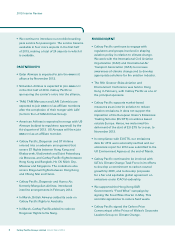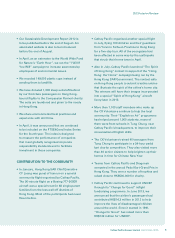Cathay Pacific 2013 Annual Report Download - page 20
Download and view the complete annual report
Please find page 20 of the 2013 Cathay Pacific annual report below. You can navigate through the pages in the report by either clicking on the pages listed below, or by using the keyword search tool below to find specific information within the annual report.
Cathay Pacific Airways Limited Interim Report 201318
Review of Operations
• In the first half of 2013 we did our best to align
capacity with demand and to maintain load
factor and yield. We reduced our schedules and
made ad hoc flight cancellations. We carried
more cargo in the bellies of passenger aircraft in
order to reduce costs.
• Demand for cargo shipments from our main
market, Hong Kong, remained weak. In the light
of increasing competition on European routes,
we merged flights in order to manage capacity.
Demand on transpacific routes was more robust
but was still below expectations. Demand on
routes within Asia was relatively robust, but
yields were under pressure due to surplus
capacity made available by other airlines.
• Competition for shipments from Shanghai
remained strong. We merged our Chengdu
and Chongqing routes in order to reduce costs
and to make ourselves more competitive. We
reduced the Zhengzhou schedule from six
flights a week to three due to reduced demand
from major hi-tech manufacturers.
• In North Asia, demand for shipments
from Japan was significantly weaker. The
depreciation of the yen has not, as yet, helped to
revive exports. The performance of our Taiwan
and Korea routes was below expectations.
• In Southeast Asia, demand for shipments of hi-
tech consumer products from Hanoi was strong.
We split the Hanoi-Dhaka service to enable more
tonnage to be carried from both places. We also
put on additional Hanoi services.
• Weak demand for shipments from Hong Kong
itself resulted in more space being available on
transpacific flights from Hong Kong. Some of
this space was used for shipments transiting
Hong Kong from the Indian sub-continent.
• Demand for shipments (particularly, from
May, of perishables) from North America was
relatively strong.
• Subject to government approval, we will start
flying to Guadalajara in Mexico in the last
quarter of 2013. We will operate two flights
a week using our Boeing 747-8F freighters.
We expect to carry shipments of automotive
parts and hi-tech products to Guadalajara,
and shipments of automotive products and
perishables from Guadalajara.
• Demand for shipments to and from the
Southwest Pacific was steady, particularly
for shipments of perishables destined for
Asianmarkets.
• We suspended cargo services to Brussels
and Stockholm in February, due to continued
weak demand for cargo shipments to and
fromEurope.
• In Europe, we focused on priority and special
cargo, for example pharmaceuticals and aircraft
engines, in an effort to maintain yield.
• High fuel prices continued to affect the
financial performance of our cargo operations,
particularly on long-haul routes. We continued
to improve the efficiency of our freighter fleet.
























